Please report any broken links or trouble you might come across to the Webmaster.
Please take a moment to let us know so that we can correct any problems and make your visit as enjoyable and as informative as possible.
| Click On Image For Full Size | Size | Image Description | Source | |
|---|---|---|---|---|
 | 1.16k | L Class Profile Inboard; Profile Outboard. | National Archives Identifier: 78116763 Photo courtesy of catalog.archives.gov | |
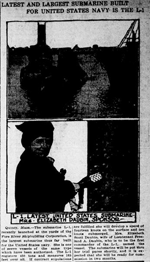 0804000 |
NR | LATEST AND LARGEST SUBMARINE BUILT FOR UNITED STATES NAVY IS THE L-1 (SS-40) The submarine L-1, recently launched at the yards of the Fore River Shipbuilding Corporation, is the largest submarine thus far built for the United States navy. She is one of seven vessels of the same type which have been authorized. The L-1 registers 450 tons and measures 165 feet over all. If contract obligations are fulfilled she will develop a speed of fourteen knots on the surface and ten knots submerged. Mrs. Elizabeth Scott Daubin, wife of Lieutenant Freeland A. Daubin, who is to be the first commander of the L-1, named the vessel. The submarine will be put thru her trial paces shortly, and it is expected that she will be ready for commission in two months. | Image and text provided by State Historical Society of Iowa. Photo from Evening Times-Republican. [volume] (Marshalltown, Iowa) 1890-1923, 02 March 1915, Image 12, via chroniclingamerica.loc.gov. |
|
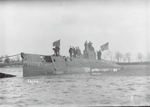 |
1.83 | The submarine torpedoboat, L-1 (SS-40), the largest of its kind ever built for the United States, has just been launched at the Fore River shipbuilding yards, at Quincy, Mass. | Photo by Bettmann via Getty Images courtesy of gettyimages.com. | |
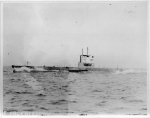 |
65k | L-1 (SS-40), port side view, underway off Provincetown, Mass. March 1915. Note her canvas enclosed bridge, which was standard feature until the advent of the N-Class. | USN photo # 19-N-11481, from the National Archives and Records Administration (NARA), courtesy of Daniel Dunham. | |
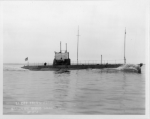 |
82k | L-1 (SS-40), starboard side view, underway off Provincetown, Mass, March 1915 underway at 14 knots. | USN photo # 19-N-39-17-2A, from the National Archives and Records Administration (NARA), courtesy of Daniel Dunham. | |
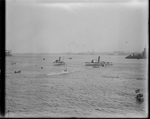 |
924k | Sub L-1 (SS-40) breaking surface after trial run, 13 May 1916. | Photo courtesy of the Boston Public Library, Leslie Jones Collection via Sean Hert & flickr.com. | |
 |
743k | All the news that's fit to misprint, #1. UNITED STATES TESTS FIRST OF BIG NEW SEA-GOING SUBMARINES The M-1 (SS-47) is shown on her trial trip off Provincetown, Mass., on 6 July. She is 230 1/2 feet long, with 21 1/2-foot beam. Her radius of action is 2,000 miles. She is not as large as the German submarine Deutschland, now at Baltimore, whose length is 315 feet, with a 30 foot beam. It is actually an EB design L-class boat. The paper that originally published the photo misidentified it. The caption is wrong. | Photo & text i.d. courtesy of David Johnston Image provided by: Penn State University Libraries; University Park, PA. Photo from Evening Public Ledger. (Philadelphia [Pa.]) 1914-1942, 11 July 1916, Night Extra, Image 2, via chroniclingamerica.loc.gov. | |
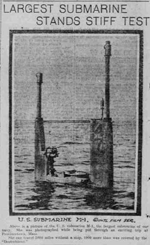 |
531k | All the news that's fit to misprint, # 2. LARGEST SUBMARINE STANDS STIFF TEST Above is a picture of the U.S. submarine M-1 (SS-47) the largest submarine of our navy. She was photographed while being put through an exciting trip at Provincetown. Mass. She can travel 5000 miles without a stop, 1000 more than was covered by the Deutschland.". It is actually an EB design L-class boat. The paper that originally published the photo misidentified it. The caption is wrong. | Photo & text i.d. courtesy of David Johnston Image and text provided by University of North Texas; Denton, TX. Photo from El Paso Herald. (El Paso, Tex.) 1901-1931, 21 July 1916, HOME EDITION, Image 6, via chroniclingamerica.loc.gov. | |
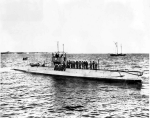 |
166k | Starboard side view of the L-1 (SS-40) off Hampton Roads, 13 December 1916. | USN photo courtesy of ussubvetsofwwii.org. | |
 |
404k | L-1 (SS-40), starboard side view anchored off of Hampton Roads, 13 December 1916. | National Archives Identifier: 45513693 Local Identifier: 165-WW-338B-2 Photo courtesy of catalog.archives.gov | |
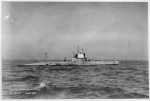 |
112k | L-1 (SS-40), starboard view, underway at Hampton Roads, 13 December 1916. | USN photo # 19-N-1891, from the National Archives and Records Administration (NARA), courtesy of Daniel Dunham. | |
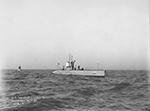 |
447k | L-1 (SS-40) and L-3 (SS-42) starboard side view anchored off of Hampton Roads, 13 December 1916. | National Archives Identifier: 45513719 Local Identifier: 165-WW-338B-014 Photo courtesy of catalog.archives.gov | |
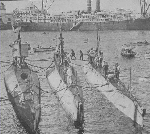 | 46k | "Officials of the City of Havana leaving the submarine L-2 (SS-41) after a ceremonious visit to a group of L-boats of the U.S. submarine division on it's recent visit to the Cuban capital. Said to have been the first time American submarines have visited that city." | Photo by Underwood & Underwood, courtesy of memory.loc.gov. Text courtesy of N.Y. Times, 14 January 1917, Page 3. |
|
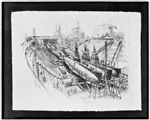 |
127k | What looks to be L-class (SS-40/51) submarines in dry dock, by the artist Joseph Pennell, 1917. | Photo # 3c19552v, LC-USZ62-119552. Photograph courtesy of memory.loc.gov. | |
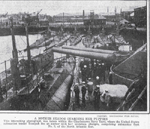 |
496k | A MOTHER SEADOG GUARDING HER PUPPIES This interesting photograph was taken within the Charlestown Navy Yard, where the United States submarine tender Tonopah (M-8) lies at anchor with her undersea charges, comprising submarine fleet No.3, of the North Atlantic fleet. Probable submarines are the E.B. designed L-boats (SS-40 / 43 & 49 / 51), [L-1 thru 4 & 9 thru 11.] | Image and text provided by Penn State University Libraries; University Park, PA. Photo from Evening Public Ledger.(Philadelphia [Pa.]) 1914-1942, 02 June 1917, Postscript Edition, Pictorial Section, Image 19, via chroniclingamerica.loc.gov. |
|
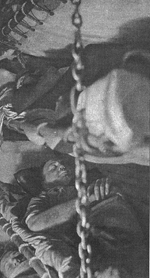 |
753k | Sack Time. Typical of the subject submarines, here men are stacked four high on canvas fold away bunks aboard an American L-boat in the European theater. | Photo from Illustrated London News, 28 September, 1918, courtesy of Beneath the Surface: World War I Submarines Built in Seattle and Vancouver by Bill Lightfoot. | |
 | 697k | L-1 (SS-40) in Bantry Bay, Ireland, with crew members standing in formation on her foredeck, 1918. | National Archives Identifier: 45513709 Local Identifier: 165-WW-338B-009 Photo courtesy of catalog.archives.gov | |
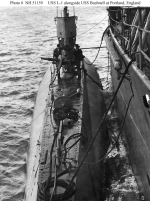 | 114k | L-1 (SS-40) alongside Bushnell (AS-2) at Portland, England, 1918. Note L-1's 3"/23 retracting deck gun trained out to starboard, and "Y-tube" hydrophone immediately behind her open foredeck hatch. Also note the boat boom attached to Bushnell's side, with pivoting mechanism at its end and walkway board on its upper surface. | USNHC photograph, # NH 51159. | |
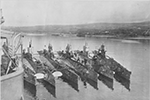 | 1.02k | L-boats alongside Bushnell (AS-2) at Bantry Bay, Ireland, in 1918.
These submarines are, from left to right: L-11 (SS-51), L-10 (SS-50), L-1 (SS-40), L-9 (SS-49) & L-2 (SS-41). Identification marks painted on these "boats"' fairwaters include the letter "A", to distinguish them from British L-boats . | National Archives Identifier: 45513695 Local Identifier: 165-WW-338B-003 Photo courtesy of catalog.archives.gov | |
 0804018 | 2.51k | L-1 (SS-40) during her WW I service over there. | Photo courtesy of digitalcommonwealth.org via the Boston Public Library, Leslie Jones Collection. | |
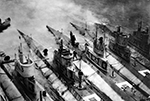 |
600k | "L" class submarines probably alongside Bushnell (AS-2) at Bantry Bay, Ireland, in 1918. L-3 (SS-42), L-1 (SS-40), L-10 (SS-50), L-4 (SS-43), L-9 (SS-49). | USN photo # Lot-5410-23,Secretary of the Navy Josephus Daniels Collection. Photographed through Mylar sleeve. Courtesy of the Library of Congress via National Museum of the U.S. Navy via flickr.com. | |
 | 403k | Signaling from the bow of the L-1 (SS-40). | USN photo courtesy of Scott Koen & ussnewyork.com. | |
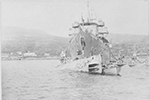 | 221k | Bushnell (AS-2) lifting L-2 (SS-41) partially out of the water, while in an Irish port during World War I.
Moored to Bushnell's
port side are (from left to right): L-4 (SS-43), L-1 (SS-40), & L-9 (SS-49). | National Archives Identifier: 45513749 Local Identifier: 165-WW-338B-28 Photo courtesy of catalog.archives.gov | |
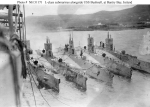 | 80k | L-boats alongside Bushnell (AS-2) at Bantry Bay, Ireland, in 1918.
These submarines are, from left to right: L-1 (SS-40), L-10 (SS-50), L-4 (SS-43)& L-9 (SS-49). | USNHC photograph, # NH 51171. | |
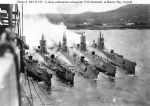 | 87k | L-boats alongside Bushnell (AS-2) at Bantry Bay, Ireland, in 1918.
These submarines are, from left to right: L-1 (SS-40), L-10 (SS-50), L-4 (SS-43)& L-9 (SS-49). Note the smoke from the submarines' engines. | USNHC photograph, # NH 51170. | |
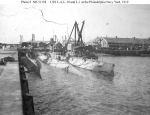 | 83k | These submarines are, from left to right: L-4 (SS-43)& L-10 (SS-50), L-1 (SS-40). At the Philadelphia Navy Yard, Pennsylvania, soon after their 1 February 1919 return to the U.S. from European waters. Note what appears to be a very long "homeward bound" pennant flying from the top of L-1's (SS-40), periscope. | USNHC photograph, # NH 51158. | |
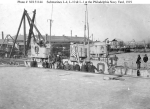 | 83k | These submarines are, from left to right: L-4 (SS-43)& L-10 (SS-50), L-1 (SS-40). At the Philadelphia Navy Yard, Pennsylvania, soon after their 1 February 1919 return to the U.S. from European waters. Note chevrons painted on the submarines' fairwaters, signifying World War I overseas service. | USNHC photograph, # NH 51144. | |
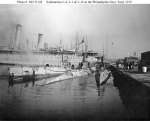 | 83k | These submarines are, from left to right: L-4 (SS-43), L-10 (SS-50), L-1 (SS-40). At the Philadelphia Navy Yard, Pennsylvania, soon after their 1 February 1919 return to the U.S. from European waters. Ship in the immediate background is either Quinnebaug (ID # 1687) or Saranac (ID # 1702), with the other of the two beyond her. | USNHC photograph, # NH 51142. | |
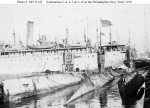 | 104k | These submarines are, from left to right: L-4 (SS-43), L-10 (SS-50), L-1 (SS-40). At the Philadelphia Navy Yard, Pennsylvania, soon after their 1 February 1919 return to the U.S. from European waters. Ship in the immediate background is either Quinnebaug (ID # 1687) or Saranac (ID # 1702), with the other of the two beyond her. | USNHC photograph, # NH 51143. | |
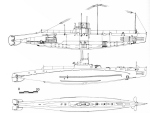 |
90k | E.B.'s L-1 (SS-40) is shown as designed (inboard, top) and during WW I (outboard & plan views, middle & bottom), when she served in British waters as AL-1 . Wartime modifications include installation of a disappearing mount for the 3in/23 gun and sound gear (Y-tubes on deck, on the keel & a T-shaped SC tube on deck forward of the deck Y-tube), as well as a permanent sheltered bridge. The disappearing gun mount was inspired by a German 3.5-in (88-mm)gun seen on board prewar U-Boats. This was E.B.'s first class to use independent torpedo tube shutters, rather than a single-rotating bow cap. | Drawing by Jim Christley. Text courtesy of U.S. Submarines Through 1945, An Illustrated Design History by Norman Friedman.Naval Institute Press. | |
 |
69k | WW I taught the U.S. Navy to order submarine priorities differently. At Berehaven, Ireland, in late 1918, L-1 (SS-40) displays her disappearing-mount 3 in/23 gun. The battleship Nevada (BB-36) is in the background. | Photo & text courtesy of U.S. Submarines Through 1945, An Illustrated Design History by Norman Friedman. Naval Institute Press. | |
 | 122k | Crew member posing atop L-1's (SS-40) starboard diving plane, at Berehaven, Ireland, 1918. Note line coiled on the submarine's deck. | USNHC photograph, # NH 51162. | |
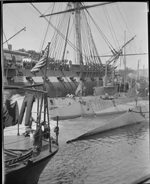 |
705k | Submarines right to left are L-3 (SS-42), L-4 (SS-43) & L-1 (SS-40) to Constitution at Boston Navy Yard, circa 1918-20. | Photo i.d. courtesy of Ric Hedman. Photo # 08_06_023224 courtesy of the Boston Public Library, Leslie Jones Collection via Sean Hert & flickr.com. |
|
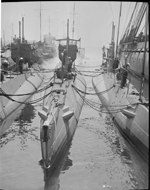 |
1.12k | Submarines left to right are L-3 (SS-42), L-4 (SS-43) & L-1 (SS-40) of the Constitution at Boston Navy Yard, circa 1918-20. | Photo # 08_06_023224 courtesy of the Boston Public Library, Leslie Jones Collection via Sean Hert & flickr.com. | |
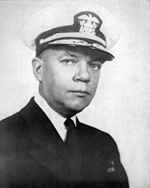 |
74k | Admiral Francis Stuart Low was born in Albany, New York, on 15 August 1894, son of the late Commander William Franklin Low, USN, and Mrs. Anna (Stuart) Low. He attended High School in Newton, Massachusetts and US Naval Academy, graduating from the latter with the Class of 1915. In 1926 he completed the junior course at the Naval War College, Newport, Rhode Island. His first assignments after graduation were in the battleship Connecticut (BB-18) and cruiser Montana (ACR-13). In the early part of his illustrious career, he was designated a submariner, and commanded the submarines D-3 (SS-19), O-9 (SS-70), L-1 (SS-40), L-2 (SS-41), S-12 (SS-117), and served on the staffs of Commander Submarine Division FIVE and Commander Control Force during and subsequent to World War One. This continuous sea duty from 1915 to 1925 was briefly interrupted for a six months assignment with the Tactical Group Submarine Chasers, New London, Connecticut. | Text & USN photo courtesy of Bill Gonyo. | |
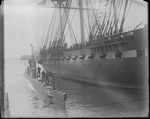 |
318k | Old and new at Navy Yard, latest class submarine, L-1 (SS-40), alongside Old Ironsides on Navy day. | Photo courtesy of the Boston Public Library, Leslie Jones Collection via Sean Hert & flickr.com. Photo i.d. courtesy of Ric Hedman. |
|
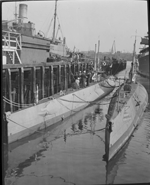 |
244k | L-1 (SS-40) & L-2 (SS-41) at Boston Navy Yard, circa 1918-20. | Photo # 08_06_023227 courtesy of the Boston Public Library, Leslie Jones Collection via Sean Hert & flickr.com. | |
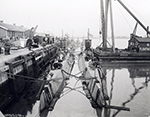 | 832k | D-3 (SS-19), at left, and D-2 (SS-18) center at the Philadelphia Navy Yard, Pennsylvania, 5 March 1919, with shipyard workmen on board. Note the ventilating fans on D-3's deck. A derrick barge is alongside D-2. Among the four submarines visible in the background are L-1 (SS-40), L-4 (SS-43) and L-10 (SS-50). A motorcycle is parked at the far left. | USNHC photograph # NH 51157. | |
 |
646k | STRUCK BY PILOT BOAT PHILADELPHIA. | Image provided by: Penn State University Libraries; University Park, PA. Photo from Evening Public Ledger. (Philadelphia [Pa.]) 1914-1942, 02 February 1921, NIGHT EXTRA, Image 15, via chroniclingamerica.loc.gov. |
|
 |
613k | Three photos here show: SAFE INSIDE THE DELAWARE BREAKWATER: The United States submarine L-1 (SS-40), rammed by the pilot boat Philadelphia off the Delaware capes early Tuesday morning was towed to safety while the heroic crew worked without rest to keep the craft afloat. IN COMMAND: Lieutenant Robert P. Luker, in charge of the wrecked submersible, assisting in the work of salvaging his ship. With him is Lieutenant Commander Halhook Gibson (right), in command of the submarine base at the Philadelphia Navy Yard. LEAVING THE L-1 : Members of the submarine's crew going to a nearby tug for a good meal and rest after assuring themselves that their boat would not sink. The position of the L-1 as it lies in the water off Lewes, Del. |
Image provided by: Penn State University Libraries; University Park, PA. Photo from Evening Public Ledger. (Philadelphia [Pa.]) 1914-1942, 04 February 1921, NIGHT EXTRA, Image 30, via chroniclingamerica.loc.gov. | |
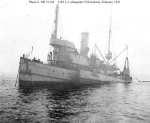 | 70k | L-1 (SS-40) tied up alongside Kalmia (AT-23) off Lewes, Delaware, on 5 February 1921. L-1's after ballast tanks have been partially filled, raising her bow. | USNHC photograph, # NH 51164, data courtesy of Gary Priolo. | |
 |
NR | "CARRIED" EIGHTY-FIVE MILES. The United States submarine L-1 (SS-40), rammed last week by a pilot boat off the Delaware capes, came into the Philadelphia Navy Yard yesterday, supported by the salvage tug Kalmia (AT-23) (left) and the navy yard tug Modoc. At the right can be seen an ten-inch pump line from the Kalmia which kept the water out of the engine hatch-room of the submersible during the trip from Lowes, Del. A smaller pump line worked from the Modoc. |
Image provided by: Penn State University Libraries; University Park, PA. Photo from Evening Public Ledger. (Philadelphia [Pa.]) 1914-1942, 08 February 1921, NIGHT EXTRA, Image 24, via chroniclingamerica.loc.gov. | |
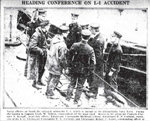 |
664k | HEADING CONFERENCE ON L-1 (SS-40) ACCIDENT | Image provided by: Penn State University Libraries; University Park, PA. Photo from Evening Public Ledger. (Philadelphia [Pa.]) 1914-1942, 10 February 1921, NIGHT EXTRA, Image 4, via chroniclingamerica.loc.gov. |
|
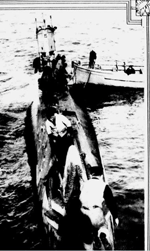 0804014 |
NR | The U. S. Submarine L-1 (SS-40), cruising off the Delaware Capes, was rammed by the steam pilot boat Philadelphia. The photo shows members of the crew of the L-l at work arranging hawsers with which attempts are being made to tow the boat to a repair station. | Image and text provided by University of Nebraska-Lincoln Libraries, Lincoln, NE. Photo from Omaha Daily Bee. (Omaha [Neb.]) 187?-1922, 13 March 1921, ROTOGRAVURE SECTION, Image 63, via chroniclingamerica.loc.gov. |
|
| Back To The Main Photo Index | Back To the Submarine Index |
|
Problems and site related matters, E-mail Webmaster |
|
This page is created and maintained by Michael Mohl All Pages © 1996 - 2024 NavSource History |